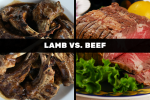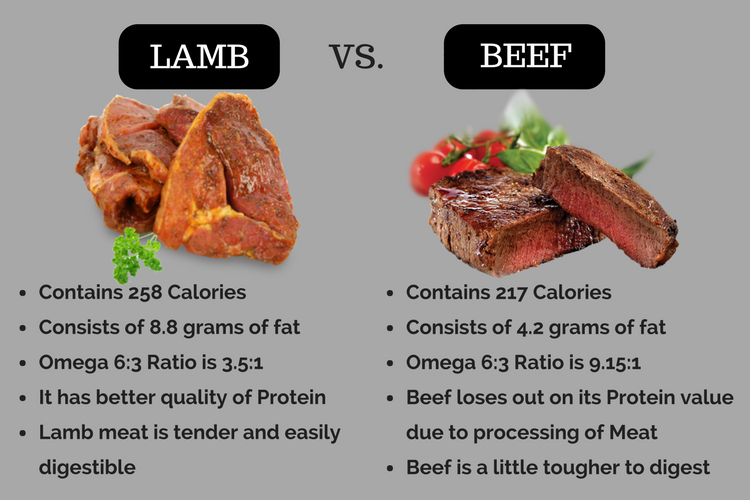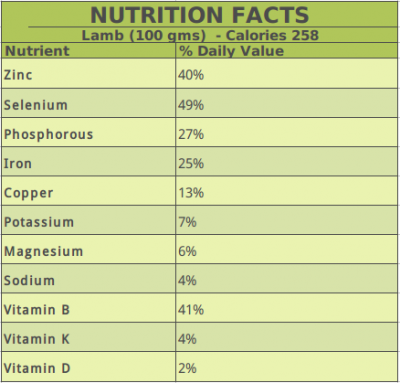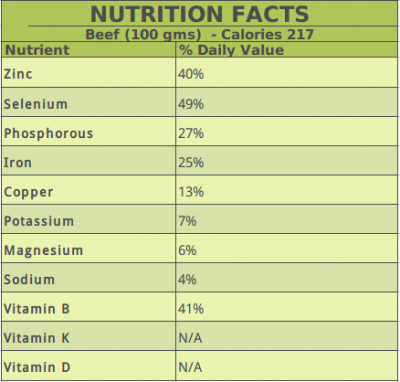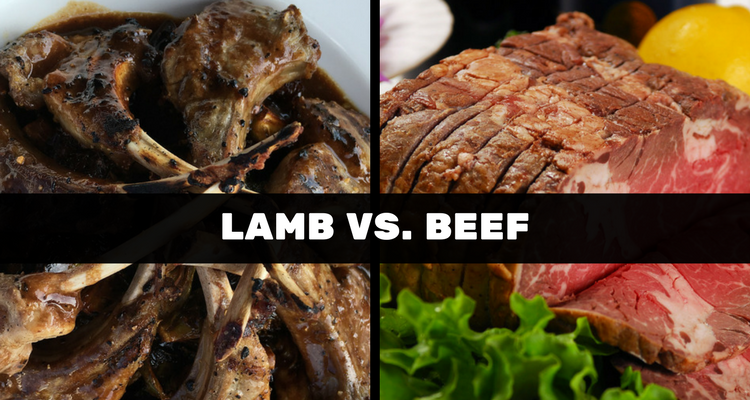
Lamb and beef are two different and widely popular varieties of red meat that have a good nutritional value. Beef is a readily available red meat, and is therefore consumed extensively, especially in the United Sates. Conversely, lamb is a staple meat in Mediterranean cuisines. In this article, we will discuss the nutritional values, benefits, and taste of lamb vs. beef.
Before we delve any further, let’s get one thing straight. Grass-fed, organic red meat is more healthy, hygienic, and nourishing than processed red meat.
Red meat is rich in minerals like zinc and phosphorus, B vitamins (niacin, vitamin B12, thiamin, and riboflavin), and is a good source of protein with large amounts of iron and creatine.
Lamb vs. Beef: Nutrition Facts
Lamb and beef are two types of red meat that are quite similar nutritionally. Lamb is the meat of a young sheep. It is tender in texture and has a strong flavor. Beef is the culinary name for cattle meat, and it has a more subtle taste than lamb. The protein content of lamb and beef is almost the same, whereas the fat content may vary.
A serving of 100 grams of lamb will provide 258 calories, 25.6 grams of protein, and 8.8 grams of fat. The same serving of beef will give 217 calories, 26.1 grams of protein, and 4.2 grams of fat.
As we can see, when comparing lamb vs. beef calories and lamb vs. beef fat, beef wins the battle in both cases. But what about the nutrient content of lamb vs. beef? Let’s take a closer look.
Lamb Nutrition Table
Red meats, such as lamb and beef, are good sources of essential minerals and vitamins. A standard serving of 100 grams of lamb contains 40% DV of zinc, 49% DV of selenium, 27% DV of phosphorus, 25% DV of iron, 13% DV of copper, seven percent DV of potassium, six percent DV of magnesium, and four percent DV of sodium.
Lamb has an impressive amount of B vitamins—41% DV of niacin, 21% DV of riboflavin, eight percent DV of thiamine, and 108% DV of vitamin B12. It also contains five percent DV of folate, four percent DV of vitamin K, and two percent DV of vitamin D.
Beef Nutrition Table
In comparison, a standard serving of 100 grams of beef contains 58% DV of zinc, 39% DV of selenium, 34% DV of iron, 29% DV of phosphorus, 10% DV of copper, seven percent DV of potassium, six percent DV of magnesium, and five percent DV of sodium.
Beef also contains B vitamins—35% DV of niacin, 14% of riboflavin, four percent DV of thiamine, 107 % DV of vitamin B12, and two percent DV of folate.
Traces of other minerals like manganese and calcium are found in both types of red meat. The nutritive value of both lamb and beef looks equally nutritious, yet lamb meat has better quality protein. This is because lamb is not processed and reared in confined factory farm conditions like cattle.
Is Lamb Healthier Than Beef?
Any type of organic, grass-fed red meat is healthy and sanitary. However, if you have to choose between lamb and beef, lamb is the better choice. The production of beef has been industrialized due to high demand.
As mentioned earlier, grass-fed animals produce a better quality cut of meat. Furthermore, lambs need to graze over grasslands.
Unlike cattle, the mass production of lamb does not supply high-quality meat. Therefore, lambs are more humanely reared, and thus are more nutritious and healthier than beef.
1. Is Lamb Fattier Than Beef?
Lamb and beef are high in saturated fats and cholesterol. But, is lamb fattier than beef? Well, yes it is. Lamb meat contains a slightly higher fat content than beef. However, the fat available in lamb is, in fact, healthy and contributes to good health.
Since lambs are fed with grass, they have a significant amount of omega-3 fats. The omega-3 to omega-6 ratio is quite amazing and is good for cardiovascular health.
Lamb tallow (fat) consists of ruminant trans fats, which are beneficial to heart health, unlike the trans fats found in hydrogenated oils.
Conjugated linoleic acid (CLA) is the most common ruminant trans fat found in red meats like lamb, beef, and veal. It has been linked to many health benefits, including the potential to reduce inflammation and body fat. This further lowers the risk of heart disease.
About 40% of lamb tallow includes a monounsaturated fat called oleic acid. This fat is also found in extra virgin oil, and is the reason for which it is lauded. Oleic acid also reduces the risk of heart disease.
In addition, lamb nutrition also includes a handful of bioactive nutrients and antioxidants such as creatine, taurine, and cholesterol. Creatine is essential for muscle health. It serves as a source of energy for muscles, and is useful in the growth and maintenance of muscle mass.
2. Meat Quality: Another Reason Lamb Is Better Than Beef
Another factor that makes lamb healthier than beef is the meat quality. Lamb is mostly grass-fed, while processed beef is obtained from cattle that are grain-fed.
Now, animals cannot fully digest whole grains, and as a result, our body cannot digest such meat. Lamb meat is easily digestible due to the presence of ruminants in the meat.
Red meat is not considered lean meat due to its high-fat content. However, the fat content varies with different cuts of meat.
Choosing lean parts of lamb and beef, such as sirloin, foreshanks, arm chop, top round, and bottom round could be a healthier choice.
Also, the lean parts of lamb meat become leaner during the cooking process. Therefore, in the battle of lamb vs. beef, lamb is a healthier red meat option.
Lamb vs. Beef: Difference in Taste
Each type of red meat has a distinct aroma, taste, and texture. The fat content plays a crucial role in bringing out the taste of the meat. In fact, it is the fat in the meat that helps us to differentiate lamb from beef.
Fat Content Affects the Taste
According to Dr. Ian Richardson, senior research fellow in Food Animal Science at Bristol University’s School of Veterinary Sciences, there are two kinds of fat in red meat.
Dr. Richardson explains that the white strip of fat around beef steak is called triglycerides, and the fats that are hidden inside the cell membrane are called phospholipids. Phospholipids contain healthier, unsaturated fats.
Removing triglycerides from the meat doesn’t affect its taste, but extracting phospholipids may impinge on the flavor.
Lamb has a specific kind of fatty acid mix called branched-chain fatty acid. This fatty acid is absent in grain-fed beef.
The branched-chain fatty acid enriches lamb with a complex gamey and earthy flavor. Lamb meat is more tender and stringy than beef.
Conversely, beef has a milder taste, which depends a lot on the cut of meat and the cooking method used.
Beef has to be cooked and spiced well. Beef that is overcooked or undercooked can have a chewy and rubbery texture.
In Lamb vs. Beef Comparison, Lamb Emerges as Winner
To conclude, in the comparison of lamb vs. beef, lamb seems to be a better choice of red meat. Grass-fed lamb and beef offer many health benefits. But, the chances of finding grass-fed beef are less than grass-fed lamb. Although lamb is slightly higher in calories than beef, it is more tasty and offers high-quality protein.
Whether you choose lamb or beef, red meat should not be a part of your everyday diet. If you must eat red meat every day, be sure to watch your portions and the cuts you eat, especially in the case of beef. Also, combine it with vegetables, nuts, and whole grains to reduce the meat content and calories.
A research study conducted at Harvard Medical School links the excessive consumption of red meat with heart disease, diabetes, and early death. The study says that the risk of premature death is even higher when processed red meats such as bacon, hot dogs, and sausages are consumed.
While red meat has health benefits, it also has fats and cholesterol. Also, the way the animals are reared is an important factor. In the case of processed meats, high sodium is also a concerning factor. With all the positives and negatives of eating red meat, it is obvious that moderation is key.
Related:
Sources:
Robb-Nicholson, C., “What’s the beef with red meat?” Harvard Medical Publications; http://www.health.harvard.edu/healthbeat/whats-the-beef-with-red-meat, last accessed April 4, 2017.


